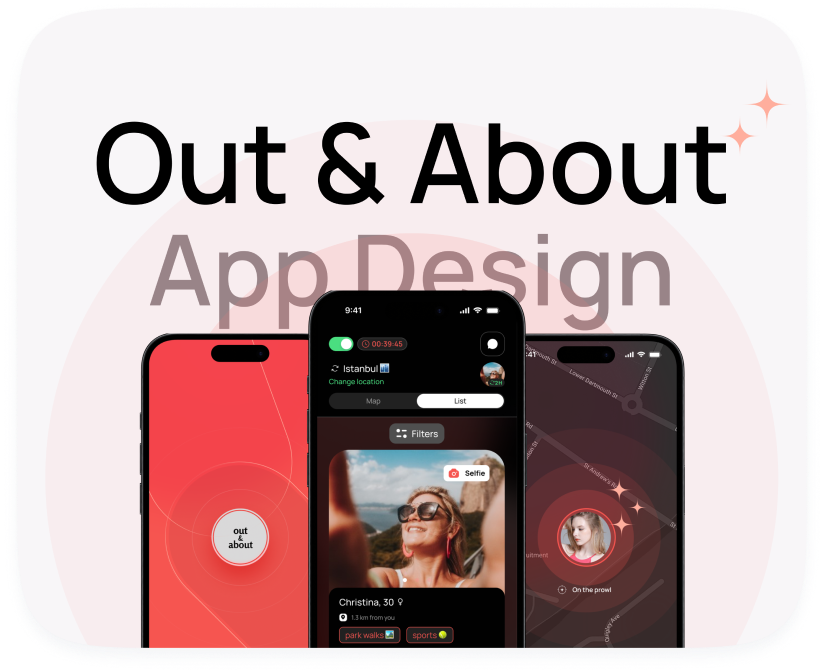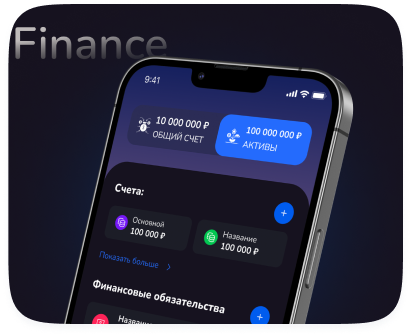
We build mobile apps





We work directly with every client
We deliver solutions with guaranteed results.

We build mobile apps






















It’s similar to buying a car at a dealership: you can go with the basic model, or choose a fully loaded version — it all depends on your needs and goals.

How to create YOUR OWN ChatGPT?

How to PROPERLY create a mobile app in 2024 | Step by step

You pay > We work > You receive the results. If you’re satisfied, you pay the next installment.
We need to have a call and discuss your specific requirements.
One thing we can say for sure: projects under 500,000 rubles are not feasible — we can’t deliver the required quality for less.
We launch, gather user feedback, and add new features that help you earn more from the app.
During development, I always design the architecture to make future updates and improvements easy and convenient.
Some apps perform better with influencer marketing, others through ad networks, and sometimes it’s even effective to buy a contact list and set up retargeting 😊
It all depends on your project’s specifics and is discussed personally.
How we can help:
- Set up ASO (App Store Optimization) and create an attractive app store page to drive free, organic installs.
- Help you develop the right promotion strategy tailored to your app.
- Share contacts of advertising experts I personally work with.
Спросить ChatGPT
The only ongoing cost is paying for the server (hosting).
You pay a subscription fee for the server. The more users your app has, the more server resources it consumes, and the higher the hosting costs.
At the early stages, when you have few users, the server will be FREE.
After that, the cost will gradually increase, but it remains affordable.
For example, an app with 100,000 users spent about $150 per month on hosting.
How Much Does It Cost to Build an App? 2025 Pricing Guide
Building a mobile app can be a game-changer for your business or a fantastic avenue for a groundbreaking idea. However, understanding the costs involved is crucial for budgeting and planning. This guide provides a detailed overview of app development costs in 2025, considering various factors and complexities.
Introduction: Decoding the App Development Price Tag
The question of "how much does it cost to build an app?" is a common one, and the answer is rarely straightforward. The price can range dramatically, from a few thousand dollars for a very basic app to hundreds of thousands (or even millions) for complex, feature-rich applications. This variability stems from a multitude of factors, including the app's complexity, the platform it targets (iOS, Android, or both), the design and user experience, the development team's location, and ongoing maintenance costs. This article delves into these factors, providing a realistic 2025 pricing guide to help you estimate the cost of your app development project.
Understanding the Key Factors Influencing App Development Costs
Several key elements contribute to the overall cost of building an app. Understanding these factors is essential for making informed decisions about your app's features and budget.
1. App Complexity and Features
The complexity of your app is the most significant cost driver. Apps with basic features like user login, profile creation, and simple data display will be less expensive than apps with advanced functionalities.
- Basic Apps: These apps typically involve simple data displays, list views, and forms. Examples include calculators, simple note-taking apps, or basic information apps.
- Medium Complexity Apps: These apps include features like user authentication, data integration with APIs, maps, social media integration, and e-commerce functionalities. Examples include restaurant finders, event management apps, or simple e-commerce platforms.
- Complex Apps: These apps often incorporate advanced technologies like artificial intelligence (AI), machine learning (ML), augmented reality (AR), virtual reality (VR), real-time data processing, and custom animations. Examples include social networking apps, gaming apps, or healthcare apps with patient data integration.
2. Platform (iOS, Android, or Cross-Platform)
The choice of platform also affects the cost. Developing for both iOS and Android generally doubles the development effort and cost. Consider your target audience and business goals when choosing a platform.
- Native Development: Developing separately for iOS (using Swift or Objective-C) and Android (using Java or Kotlin) offers the best performance and access to platform-specific features but is the most expensive option.
- Cross-Platform Development: Technologies like React Native, Flutter, and Xamarin allow you to build one codebase that can be deployed on both iOS and Android. This approach can save time and money but may compromise performance or access to certain native features.
- Hybrid Apps: Hybrid apps are built using web technologies (HTML, CSS, JavaScript) and wrapped in a native container. They are generally less expensive to develop than native apps but can suffer from performance limitations. Examples include apps built using Ionic or Cordova.
3. Design and User Experience (UI/UX)
A well-designed and user-friendly app is crucial for user engagement and retention. Investing in a professional UI/UX design can significantly improve your app's success but also contribute to the overall cost.
- UI (User Interface) Design: Focuses on the visual elements of the app, including layout, color schemes, typography, and button styles.
- UX (User Experience) Design: Focuses on the overall user flow and ease of use of the app. It involves user research, wireframing, prototyping, and usability testing.
4. Development Team Location and Expertise
The location of your development team significantly impacts the cost. Development rates vary widely across different regions. The expertise and experience of the developers also play a crucial role.
- North America & Western Europe: Typically have the highest development rates, ranging from $100 to $250+ per hour.
- Eastern Europe: Offers a good balance of quality and cost, with rates ranging from $50 to $150 per hour.
- India & Southeast Asia: Generally have the lowest development rates, ranging from $20 to $80 per hour.
5. Backend Infrastructure and APIs
Many apps require a backend infrastructure to store data, manage users, and handle complex logic. The cost of setting up and maintaining this infrastructure depends on the complexity of the app and the number of users it will support. API integration is often necessary to connect the app to external services.
- Server Costs: Hosting your backend infrastructure requires server resources, which can be provided by cloud providers like AWS, Google Cloud, or Azure. Costs vary depending on the amount of storage, processing power, and bandwidth required.
- Database Costs: Storing data requires a database, which can be either a relational database (like MySQL or PostgreSQL) or a NoSQL database (like MongoDB or Cassandra). Costs depend on the size of the database and the level of performance required.
- API Integration Costs: Connecting your app to external services via APIs often involves paying for usage fees or subscriptions.
6. Testing and Quality Assurance (QA)
Thorough testing is essential to ensure the app functions correctly and provides a positive user experience. This includes unit testing, integration testing, user acceptance testing (UAT), and performance testing.
7. Maintenance and Updates
App development doesn't end after launch. Ongoing maintenance and updates are necessary to fix bugs, add new features, and keep the app compatible with the latest operating systems and devices. Budget for ongoing maintenance costs, which typically range from 15% to 20% of the initial development cost per year.
Estimating App Development Costs: A Practical Breakdown
To provide a clearer picture, let's break down the estimated costs for different types of apps in 2025, considering the factors discussed above. These are rough estimates, and the actual cost may vary depending on your specific requirements.
1. Basic App (Simple Functionality)
- Features: Simple UI, basic data display, user login (optional).
- Platform: One platform (iOS or Android).
- Development Team: Small team or freelancer.
- Estimated Cost: $5,000 - $20,000.
- Timeframe: 1-3 months.
2. Medium Complexity App (Common Features)
- Features: User authentication, API integration, maps, social media integration.
- Platform: One platform (iOS or Android) or cross-platform.
- Development Team: Small to medium-sized team.
- Estimated Cost: $20,000 - $75,000.
- Timeframe: 3-6 months.
3. Complex App (Advanced Functionality)
- Features: AI/ML integration, AR/VR, real-time data processing, custom animations.
- Platform: Both iOS and Android.
- Development Team: Medium to large-sized team.
- Estimated Cost: $75,000 - $250,000+.
- Timeframe: 6+ months.
4. Enterprise App (Specific Business Needs)
- Features: Custom features tailored to specific business processes, integration with existing systems, high security requirements.
- Platform: Varies depending on needs.
- Development Team: Dedicated team with specialized expertise.
- Estimated Cost: $100,000 - $500,000+.
- Timeframe: 6+ months (often ongoing development).
Table: 2025 App Development Cost Estimates
| App Type | Features | Platform | Development Team | Estimated Cost | Timeframe |
|---|---|---|---|---|---|
| Basic App | Simple UI, basic data display | One Platform (iOS or Android) | Small Team/Freelancer | $5,000 - $20,000 | 1-3 Months |
| Medium Complexity App | User Authentication, API Integration, Maps | One Platform or Cross-Platform | Small to Medium Team | $20,000 - $75,000 | 3-6 Months |
| Complex App | AI/ML, AR/VR, Real-time Data | Both iOS and Android | Medium to Large Team | $75,000 - $250,000+ | 6+ Months |
| Enterprise App | Custom Features, System Integration, High Security | Varies | Dedicated Team | $100,000 - $500,000+ | 6+ Months (Ongoing) |
Tips for Reducing App Development Costs
While app development can be expensive, there are several strategies you can employ to reduce costs without compromising quality:
- Prioritize Features: Focus on the core features that are essential for your app's initial launch. You can always add more features in future updates.
- Choose Cross-Platform Development: If your target audience includes both iOS and Android users, consider using cross-platform technologies to save time and money.
- Use a Minimum Viable Product (MVP) Approach: Develop a basic version of your app with core features to test the market and gather user feedback before investing in a fully-featured version.
- Thoroughly Document Requirements: Clearly define your app's requirements and create detailed specifications to minimize misunderstandings and rework.
- Consider Outsourcing: Outsourcing development to regions with lower labor costs can significantly reduce expenses. However, carefully vet potential outsourcing partners to ensure quality.
- Use Open-Source Libraries and Frameworks: Leveraging existing open-source components can save development time and effort.
The Importance of a Detailed Project Plan
A well-defined project plan is crucial for managing app development costs effectively. The plan should include:
- Scope Definition: Clearly outline the features and functionalities to be included in the app.
- Timeline: Establish a realistic timeline for each stage of the development process.
- Budget Allocation: Allocate funds to different areas of development, such as design, development, testing, and marketing.
- Risk Management: Identify potential risks and develop mitigation strategies.
- Communication Plan: Establish clear communication channels between the development team and stakeholders.
Conclusion: Navigating the App Development Cost Landscape
Estimating the cost of building an app in 2025 requires careful consideration of various factors, including app complexity, platform choice, design requirements, development team location, and ongoing maintenance. By understanding these factors and employing cost-reduction strategies, you can effectively budget for your app development project and bring your vision to life without breaking the bank. Remember to prioritize your features, choose the right development approach, and invest in a well-defined project plan to ensure success. Ultimately, the cost of building an app is an investment in your business's future, and a well-executed app can generate significant returns.






